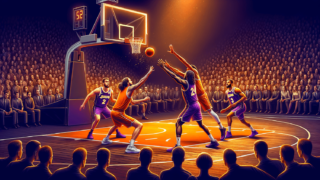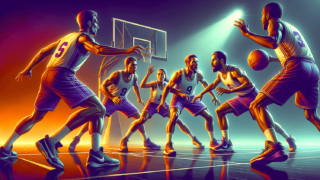
If you’re eager to delve into the exciting world of basketball, you’re in for a treat! Unraveling the secrets behind various plays and strategies is not only fascinating but essential to truly appreciate this thrilling sport. In today’s post, we’re exploring the concept of the “turnover” in basketball. Considered both notorious and inevitable, understanding this crucial aspect of the game will arm you with invaluable knowledge to wow your fellow basketball fanatics. So, buckle up and let’s dive right into the intricate dynamics of turnovers and their undeniable impact on the court!
What Is a Turnover in Basketball?
A turnover in basketball occurs when a player from one team loses possession of the ball to the opposing team, either through their own mistake or as a result of the opponent’s defensive effort. This can happen in various ways, such as when a player travels, double-dribbles, commits an offensive foul, makes a bad pass, or has the ball stolen by a defender. Turnovers are crucial game events, as they can disrupt offensive momentum and provide scoring opportunities for the other team.
Analyzing the Causes of Turnovers in Basketball
Turnovers can result from a variety of scenarios developing on the basketball court. By dissecting these different situations, we can better understand the underlying causes and learn how to minimize turnovers in future games. Let’s explore some of the most common types of turnovers and why they occur.
Traveling
Traveling is one of the leading causes of turnovers in basketball. It occurs when a player takes too many steps without dribbling the ball. This violation gives the opposing team an opportunity to regain possession of the ball and potentially score. Poor footwork or misjudging the timing of a dribble can lead to traveling. Strengthening fundamental skills and practicing proper footwork can help players avoid turnovers due to traveling.
Double Dribble
Double dribble is another common turnover-causing violation. This infraction occurs when a player either stops dribbling, touches the ball with both hands, and then starts dribbling again, or when a player dribbles with both hands simultaneously. To prevent double-dribble turnovers, players should practice their dribbling skills and become more adept at controlling the ball with one hand at a time.
Offensive Fouls
At times, aggressive gameplay can lead to turnovers through offensive fouls. These fouls happen when a player initiates illegal contact with a defender. Common examples include charging into a stationary defender or using an elbow to create space. To minimize the risk of offensive fouls, players should work on their offensive moves and focus on using proper technique when trying to score or get open.
Bad Passes and Stolen Balls
Turnovers can also occur when a player executes a poor pass, which is then easily intercepted by the opposing team. Additionally, a defender may successfully steal the ball from an offensive player. These turnovers can arise from poor decision-making, lack of court awareness, or simply being outplayed by a more skillful defender. To limit turnovers due to bad passes and stolen balls, players should hone their passing accuracy, develop stronger ball-handling skills, and build better court awareness.
Effective Ways to Reduce Turnovers in Basketball
Now that we’ve investigated the causes of turnovers in basketball, let’s delve into effective strategies to reduce them in a game. By refining essential skills and incorporating comprehensive tactics, a team can increase their chances of victory and maintain control on the court.
Emphasize Fundamentals
Basketball fundamentals, such as dribbling, passing, and shooting, form the foundation of success on the court. Regularly practicing these basic skills develops muscle memory, which can help eliminate mistakes that often lead to turnovers. Players should set aside time to work on their footwork, dribbling, and court awareness, ensuring they can rely on their fundamentals when under pressure.
Develop Patience
It’s no secret that basketball is a fast-paced sport, but sometimes slowing down and exercising patience pays off. Players who play with restraint and wait for the opportune moment to make their move are less likely to commit turnovers. This approach can lead to better decision-making and more effective plays, ultimately enhancing the team’s overall performance.
Prioritize Communication
On the court, communication is key. Constant and effective communication among teammates can prevent many turnovers by clarifying offensive strategies and helping players adjust to the defense. Strong communication can create more open passing lanes, limit miscommunication errors, and prepare teammates to anticipate a pass or adjust their positioning when necessary. A team that is in sync is less likely to make costly mistakes.
Develop a Strong Team Defense
While minimizing a team’s own turnovers is essential, creating turnovers for the opposing team can also contribute to a successful performance. By developing a solid team defense and utilizing defensive plays that force turnovers, a team can capitalize on their opponents’ mistakes and create additional scoring opportunities. This tactic can also increase pressure on the opposing team, leading to more unforced errors and boosting the chances of success.
Turnovers and the Impact on Performance
Turnovers represent a major aspect of basketball that significantly influences a team’s success. Understanding the effects of turnovers on both individual players and team performance is crucial for anyone looking to master the game.
Offensive Efficiency
Turnovers have a direct correlation with a team’s offensive efficiency. By limiting turnovers, a team can maximize their offensive possessions and increase their scoring opportunities. Reducing turnovers leads to more valuable possessions, and ultimately, a higher likelihood of scoring points.
Defensive Strategy
Turnovers also play an important role in defensive strategy. A strong defensive plan can exploit an opponent’s weaknesses and force them into committing turnovers. When a team effectively generates turnovers on the defensive end, it limits the opposing team’s scoring opportunities and creates fast-break chances to capitalize on the opponent’s mistakes.
Momentum and Confidence
The game of basketball involves a lot of momentum. A string of turnovers can significantly impact a team’s confidence and alter the pace of the game. On the other hand, a series of successful offensive possessions, combined with forcing turnovers on defense, can give momentum to the team and make the game more exhilarating. Maintaining momentum is critical for a team’s overall morale and can noticeably impact their performance on the court.
Turning Turnovers into Opportunities
Now that we have a comprehensive understanding of the causes and consequences of turnovers in basketball, we can appreciate how minimizing them is essential for a team’s success. By implementing targeted strategies and focusing on refining the fundamentals, a team can reduce turnovers and take advantage of the opportunities they present. Next time you watch or play basketball, you’ll have a deeper appreciation for the significance of turnovers and be better equipped to analyze and understand their implications on the game.
Famous Basketball Players Known for Their Ball Security
Reducing the number of turnovers and maintaining ball security is an essential skill set for professional basketball players. Adeptness in ball security can be a game-changer and a substantial asset for a team’s success. Several famous basketball players have become renowned for their exceptional ball security on the court. Let’s explore a few of these legends and their remarkable accomplishments.
Chris Paul
Chris Paul, an NBA All-Star point guard, has consistently displayed exceptional ball security throughout his career. His ability to thread the needle with precise passes and limited turnovers has proven indispensable to his team’s success. As a result, he has become one of the most revered and skilled playmakers in basketball history.
Steve Nash
Two-time NBA Most Valuable Player (MVP) Steve Nash is another point guard who consistently demonstrated outstanding ball security during his illustrious career. With an uncanny ability to navigate the court and maintain possession, Nash showcased skillful leadership on the floor and sharp decision-making that often left opponents perplexed and frustrated.
John Stockton
John Stockton, a Hall of Fame point guard, was known for his impeccable ability to orchestrate his team’s offense while maintaining stellar ball security. Even though he ranks high on the career assists and steals lists, his remarkable career low turnover rate sets him apart as one of the most efficient point guards in NBA history.
Developing Defensive Capabilities to Force Turnovers
Similar to enhancing ball security skills, developing strong defensive capabilities is crucial for forcing turnovers and securing possession for one’s team. Employing strategic defensive techniques can profoundly impact a team’s success on the court. Below, we detail how to build essential defensive skills to create turnovers and benefit your team.
Active Hands
Maintaining active hands on defense is vital for disrupting opponents’ offensive strategies and causing turnovers. Quick hands can make it challenging for the opponent to pass or dribble, increasing their likelihood of committing a mistake or turning over the ball. To develop an active hands defense, players should practice swiping, poking, and deflecting the ball during practice and game situations.
Anticipation and Awareness
A crucial aspect of generating turnovers on the defensive end lies in a player’s anticipation and awareness. By reading the opponent’s body language, understanding their tactics, and staying aware of the ball’s position, defenders can predict and intercept passes, ultimately forcing turnovers. Enhancing these skills involves studying opponent’s moves, keeping an eye on the ball, and refining footwork to stay agile and ready for any circumstance.
Pressure Defense
Asserting pressure on the opponent or trapping them in specific areas of the court can help create turnovers. A well-executed pressure defense often forces the opponent to make hasty decisions or errant passes, resulting in a change of possession. Teams can implement full-court or half-court press strategies to enhance their pressure defense and increase the chances of forcing turnovers.
Defensive Communication
Lastly, successful communication among teammates is essential when executing a defensive strategy designed to force turnovers. By actively discussing opponents’ moves, adjusting positions, and calling out screens, teammates can work cohesively to disrupt the opposing team’s offensive agenda. Building strong defensive communication habits can make a significant difference in a team’s ability to generate turnovers and improve overall performance on the court.
Frequently Asked Questions
We’ve compiled a list of frequently asked questions related to turnovers in basketball to help readers further understand this essential aspect of the game. These concise and informative answers address both offensive and defensive aspects of turnovers, as well as their impact on overall gameplay and team success.
1. What counts as a turnover in basketball?
In basketball, a turnover occurs when a player from one team loses possession of the ball to the opposing team, either through their own mistake or as a result of the opponent’s defensive effort. Common examples of turnovers include traveling, double-dribble, offensive fouls, bad passes, and stolen balls.
2. How can players reduce turnovers in a game?
Players can reduce turnovers by emphasizing fundamentals (dribbling, passing, and footwork), developing patience and restraint, prioritizing communication with teammates, and maintaining good court awareness.
3. Why are turnovers considered a negative aspect of a team’s performance?
Turnovers are considered negative because they give the opposing team possession of the ball and an opportunity to score, disrupting offensive momentum and potentially impacting the team’s confidence.
4. How do turnovers affect a team’s offensive efficiency?
Turnovers can diminish a team’s offensive efficiency because they result in lost scoring opportunities. By minimizing turnovers, a team can gain more valuable possessions, increasing their chances of scoring points.
5. How can teams use defensive strategies to force turnovers?
Teams can use defensive strategies such as active hands, anticipation and awareness, pressure defense, and effective communication among teammates to disrupt the opponent’s offense and force turnovers.
6. What is a full-court press defense?
A full-court press defense is a defensive strategy that involves applying pressure on the opposing team across the entire court length. The goal is to force the opponent to commit turnovers and disrupt their offensive rhythm.
7. What is the difference between forced and unforced turnovers?
Forced turnovers result from the defensive effort of the opposing team, such as steals or interceptions. Unforced turnovers occur due to mistakes made by the offensive team without direct defensive pressure, like errant passes or traveling violations.
8. Can turnovers lead to fast-break opportunities?
Yes, turnovers often lead to fast-break opportunities because they can catch the opposing team off-guard, creating a momentary advantage in numbers, spacing, or both for the team that forces the turnover.
9. How do turnovers affect a game’s momentum?
Turnovers can significantly impact a game’s momentum. A string of turnovers can lower a team’s confidence and alter the pace of the game, while consecutive successful offensive possessions combined with forced turnovers on defense can boost a team’s morale and momentum.
10. Which players are most prone to committing turnovers?
Typically, guards and playmakers who handle the ball most often are more prone to committing turnovers, as they play a significant role in setting up plays and coordinating offensive strategies. However, turnovers can also occur among forwards and centers if they struggle with poor footwork, ball handling, or court awareness.
11. How do teams track turnovers during a game?
Teams and coaching staff track turnovers by monitoring turnovers committed by their own players, as well as turnovers forced on the opposing team. These statistics can provide valuable insights into the team’s offensive efficiency and defensive capabilities.
12. How are turnover statistics used by coaches and analysts?
Turnover statistics can help coaches and analysts identify areas where a team or specific players need improvement. High turnover rates can indicate a need for better ball handling, passing skills, decision making, or defense. Reducing turnover rates can greatly impact a team’s success on the court.
13. Which famous basketball players are known for their exceptional ball security?
Some famous basketball players known for their exceptional ball security include Chris Paul, Steve Nash, and John Stockton. These point guards consistently demonstrated strong ball handling, decision making, and court awareness, resulting in low turnover rates and more efficient offensive strategies.
Featured Posts
- No pillar pages found.




